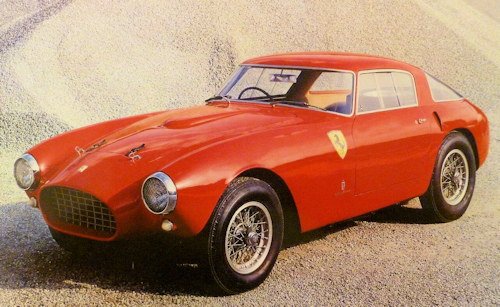Ferrari 250MM
 |
|
|
Manufacturer |
Ferrari |
|
Production |
1952 to 1954 |
|
Produced |
31 |
|
Designers |
Vignale,Pinin Farina |
|
Body |
Spyder,Berlinetta |
|
Layout |
Front mid-engine, rear-wheel-drive |
|
Engine |
2953.21 cc Colombo V12 |
|
Power |
240 PS |
|
Induction |
3 Weber twin carburettors |
|
Transmission |
manual 4-5 speed |
|
Wheelbase |
2,400 mm (94.5 in) |
|
Curb weight |
900 kg berlinetta, 850 kg spyder |
The Ferrari 250MM was a racing sports car, which was developed in 1953 at the Scuderia Ferrari The "MM" stood for the Mille Miglia .
History
In October 1952, Enzo Ferrari caused quite a stir among the audience when he presented a chassis with engine but no body at the Paris Motor Show .The first 250 MM, in a spyder form, was presented in 1952 at the Paris Motor Show. The first berlinetta was also shown in Paris in but a year later. A single berlinetta by Vignale, created in 1954. The chassis was built similar to the Ferrari 250S , which remained a single piece. The engine in the exhibit was also a spare unit from the 250S. In the spring of 1953 Ferrari presented at the Geneva Motor Show the final product, the 250MM as the successor to the 250S. The technology of the chassis remained as good as unchanged. In the suspensions there were front double wishbones and transverse leaf springs and rear a rigid axle with longitudinal leaf springs.
The Barchetta body of the exhibition car in Geneva was made by Pininfarina . This first 250MM established the collaboration between Ferrari and Battista Pininfarina . In contrast to the 250S, the 250MM was manufactured in a large number for a racing sports car of the 1950s. At Pininfarina 18 barchettas were built; In addition came 13 Spyder from the Carrozzeria of Vignaleand another coupe from the workshop of Oscar- working company Moreli.Aurelio Lampredi made a further increase in performance of the yet developed by Gioacchino Colombo 3-liter V12 engine . It was achieved by a change in the mixture preparation. The previous three Weber double carburetors were replaced by quad carburetors, which provided 10 hp more power (increase from 230 to 240 hp).
Race History
Due to the large number of vehicles, the 250MM was used from the beginning alongside the factory team of private teams and drivers. The first race with a 250MM (Chassis 0236MM) had in April 1953, the Frenchman Pierre Boncompagni the Coupes de Vitesse at the Autodrome de Linas-Montlhéry where he left Franco Bordoni in Gordini T15S was second .The first factory operation was on the same day in another race. Giulio Cabianca drove chassis 0282MM at the Giro di Sicilia , but dropped out. Seven days later, Phil Hill won the 250MM sports car race in Pebble Beach , celebrating the 250MM's first race win . At the 1953 Mille Miglia , eight were 250MM at the start, including Roberto Rossellini and the works cars of Giovanni Bracco and Mike Hawthorn . Cabianca came in ninth.
In summer, Luigi Villoresi won the Grand Prix of Monza and Paolo Marzotto the Coppa d'Oro delle Dolomiti . The Scuderia renounced from 1954 on the use of 250MM and sold the remaining works cars. In the 1950s, the 250MM were successful racing cars and were driven until 1962. The last bet there were 1,962 of Bad fist in a national sports car race in North America .Overall, the model 250MM was driven 219 times at races; There were 26 overall and 29 class wins and a total of 64 podium finishes.
Technical
-
Ferrari 250 MM Technical data (1952-1954)
engine
Twelve-cylinder V-engine (60 °)
capacity
2953 cc
Bore × stroke
73 × 58.8 mm
power
240 hp (176 kW) at 7200 rpm
valve control
overhead camshaft
compression
9: 1
mixture preparation
3 Weber twin carburettors 36 IF 4 / C
clutch
Three-disc dry clutch
transmission
Five-speed gearbox, synchronized
rear-wheel driveframe
two side members with trusses
Front suspension
two triangle wishbones, transverse leaf spring,
shock absorbers horizontally between the two upper wishbonesRear suspension
Rigid axle with push rods, semi-elliptic leaf springs, shock absorbers
wheelbase
2400 mm
gauge
front 1300 mm, rear 1320 mm
wheel size
front 4.00 × 16, rear 5.00 × 16 (Borrani spoke wheels)
wheel size
front 5.50 × 16, rear 6.00 × 16
Curb weight (without driver)
850 kg
